Welcome to Part 3 of the MMA Training Bible’s article series on periodization. In Part 1 of the series, you learned that periodization is the process of organizing your training into different phases to the end of managing fatigue, lowering your potential for over-training, and optimizing your performance on fight day. In Part 2, you learned all about the big phases; the general prep phase, the fight-specific phase, the fight camp, the taper, and the transition. You learned that if you arrange your training in the order I showed you to, you can avoid over-training, dissipate your fatigue, and cause a peak in your performance before your fight.
In the present article, we’re going to move one level down, and talk about how to organize the sub-phases. Just in case you’ve forgotten what the whole fight schedule looks like, here it is again (you should be able to draw this from memory by now).
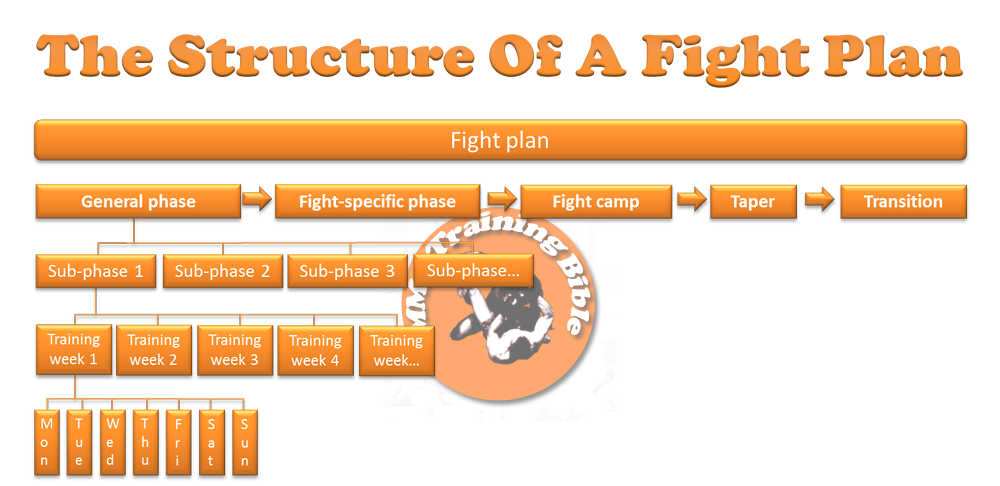
As you can see, training phases are divided into sub-phases. Training sub-phases typically last about four weeks. But not all sub-phases are created equal. What really makes one training sub-phase different from another training sub-phase is its difficulty and the type of loading plan it uses (1, 3).
Don’t worry if you haven’t heard of these terms before because I will explain them. Just as a side note, these are two simple concepts that you must grasp before moving on. Let’s first talk about the concept of training difficulty.
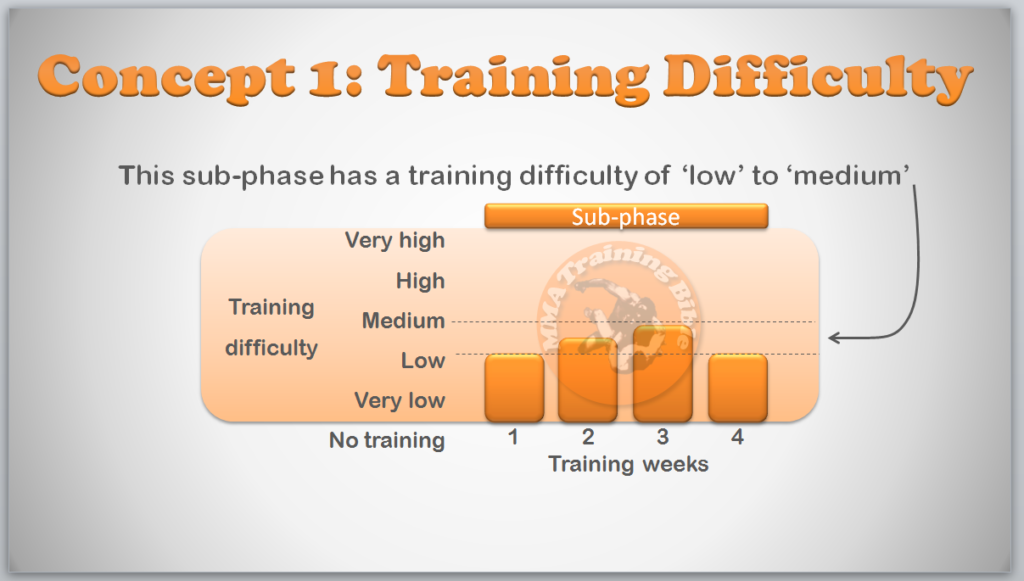
Training difficulty just describes how difficult your training weeks are, and of course that will influence how difficult the whole training sub-phase is. On the left hand side of the figure above, you can see that training difficulty is classified as either ‘very high’, ‘high’, ‘medium’, ‘low’, ‘very low’, or ‘no training’ (1).
By referring to the total training difficulty of a training week or training sub-phase, rather than the volume and intensity, you better describe the true difficulty of training. This is because training volume and intensity don’t really account for the type of exercise that you’re performing, which can really influence the difficulty of a training session. For example, performing 10 take-downs at 100 % intensity is more physically demanding than performing 10 jabs at 100 % intensity, even though the training intensity and training volume are the same between these two workouts.
If you want to equate training difficulty between these sessions, you need to increase the volume of the jab workout, or decrease the volume in the take-down workout. For this reason, The MMA Training Bible uses the term ‘training difficulty’ to describe the difficulty of training weeks and training sub-phases, rather than volume and intensity. Ok, so that’s concept #1, let’s move on to Concept #2: ‘Loading plan’.

The loading plan just describes how the training difficulty changes across the weeks of a sub-phase. For example, the sub-phase on the left hand side of the above figure uses a loading plan of 1:1; meaning, one difficult week is followed by one less difficult week (i.e. recovery week). The middle sub-phases uses a loading plan of 2:1, with two weeks of increasingly difficult training, followed by one recovery week. Lastly, the sub-phase shown on the right side of the figure uses a 3:1 loading plan, which features three weeks of increasingly difficult training, followed by one recovery week. Pretty simple right?
So now you know why training sub-phases are not all created equal (i.e. because they differ in their training difficulty and the loading plan). And that makes sense because you know that you can’t train at the same difficulty all the time; some sub-phases will be easy, some are going to be hard, and some are going to be very hard; this is a very important concept in periodization.
There are actually four different types of sub-phases that the MMA Training Bible uses to help you manage your fatigue on a month-to-month basis. They are: developmental sub-phases, shock sub-phases, the tapering sub-phase and the transition sub-phase.
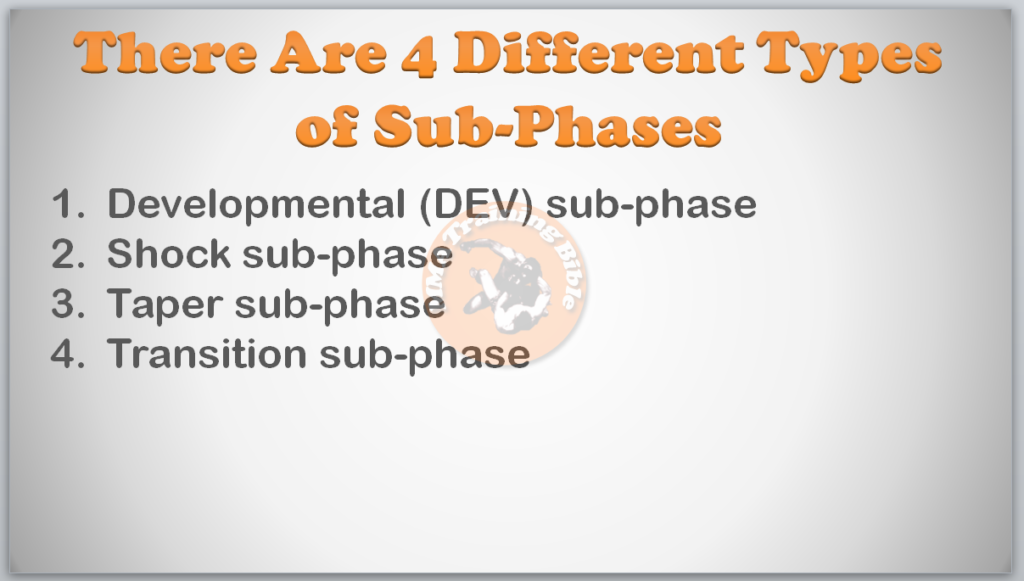
To make sure you get this, I want to give you an example of each, so let’s start with developmental sub-phases.
Developmental sub-phases
Developmental sub-phases should be used throughout your entire fight plan, all year round. They progress gradually in training difficulty over a sub-phase, like a staircase, and generally achieve their highest training difficulty just before a recovery week at the end. Here is an example of a developmental sub-phase using a 3:1 loading plan.

Novice/beginner fighters should start with one loading week (low training difficulty) followed by one recovery week (i.e. a loading plan of 1:1), progressing to a 2:1, 3:1 or 4:1 loading plan with training difficulty increasing in a step-wise manner (1, 3).

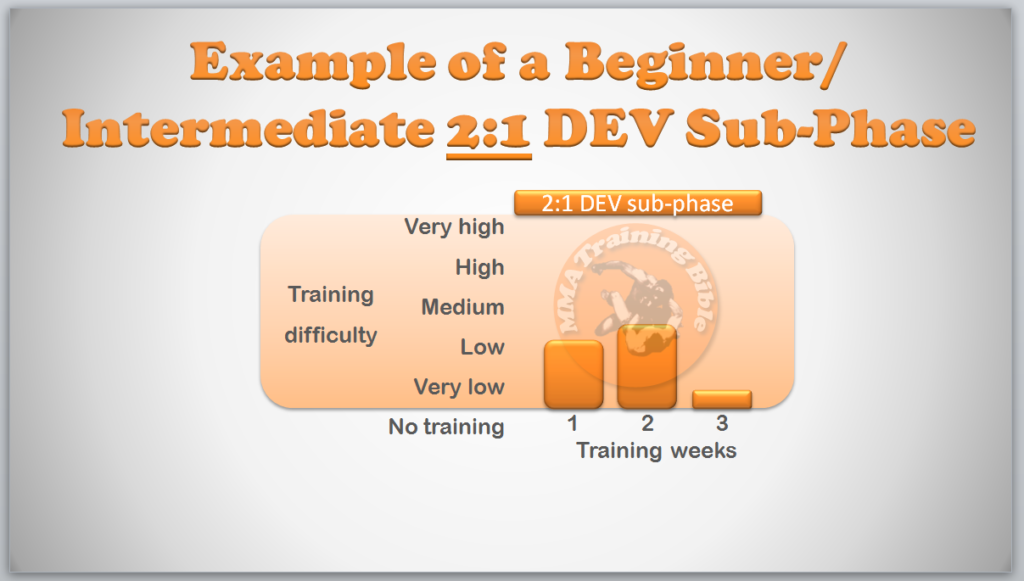
More advanced fighters can begin the general preparatory phase with more demanding loading plans (starting at medium training difficulty, using a 3:1 or 4:1 loading plan) because they should have a sufficient base of endurance and strength from previous training.
It should be noted that more recovery time is required as the number of progressive loading steps increases (1). If you find that a previously planned sub-phase is loaded too high, just add another recovery week. So that’s a developmental sub-phase, let’s have a look at the shock sub-phase.
Shock sub-phase
Shock sub-phases feature a sharp increase in training difficulty over one to three weeks, followed by a recovery week. Sharply increasing training difficulty every once in a while is a useful tool for breaking through plateaus in performance, which will occur after about three weeks of training with the same loads (2).

The adaptations that result from the sudden increase in training difficulty can appear as quickly as 10 days (2), but it is important to remember that the higher the training stress, the longer time it takes to dissipate the fatigue and to undergo supercompensation; some researchers have even suggested that performance gains may not occur sooner than 4 to 12 weeks after a period of very intense training (1); but I’m not convinced, I haven’t seen these studies, if you have, please let me know.
It’s probably safe to say that shock sub-phases should not be used within three weeks of a fight because any positive physiological adaptation that could be gained from them wouldn’t present until after your fight anyway. Also, shock sub-phases should not be planned back-to-back, as this will most probably result in over-training.
I want to give you an example of how to build in shock sub-phase. In the below figure, you will notice that a developmental sub-phase is used prior to a shock sub-phase. The big difference between the two sub-phases is found in week 7, when there is a sharp increase in training difficulty (that’s what makes this sub-phase a ‘shock’ sub-phase).

After you’ve completed your first shock sub-phase, you’ll likely plan to complete a few developmental sub-phase. Eventually, you’ll want to incorporate another shock sub-phase into your training. This time, your shock sub-phase should incorporate two training weeks that feature a sharp increase in training difficulty. This is shown in the figure below.
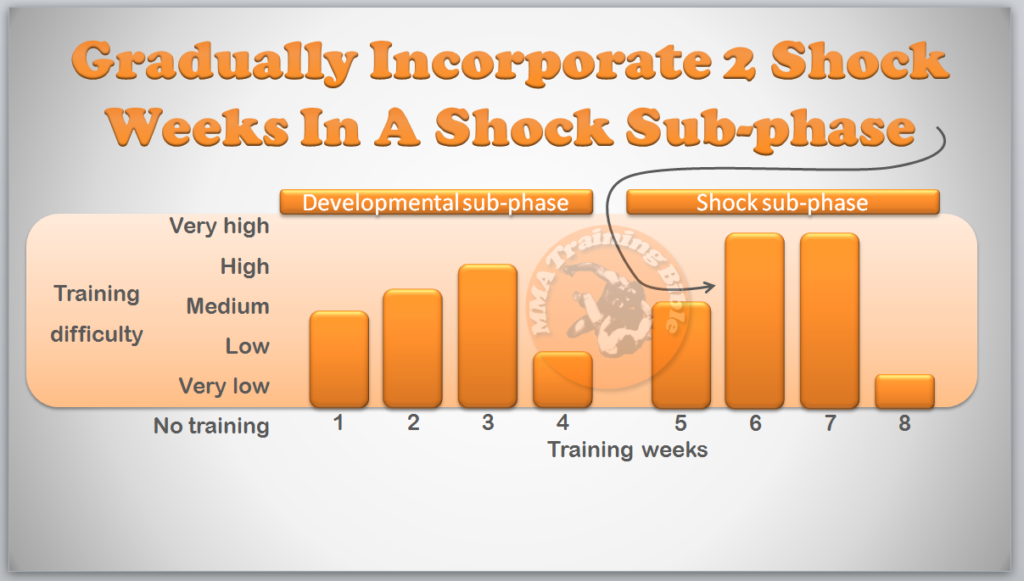
Similarly, after you’ve completed your second shock sub-phase, you should complete a few developmental sub-phase. Eventually, you’ll want to incorporate another shock sub-phase into your training. This time, your shock sub-phase should incorporate three training weeks that feature a sharp increase in training difficulty. This is shown in the figure below.

Beginners can first start to incorporate shock sub-phases at the end of the general preparatory period, after a base of endurance and strength has been developed. Intermediate/advanced fighters who have a solid base of strength can use them earlier in training.Ok, let’s move on to the taper sub-phase.
Taper sub-phase
The taper sub-phase is pretty simple, you only use it before a fight, when you’re trying to peak. The taper sub-phase features a large drop in training difficulty over two weeks before the fight. Here is an example of what a taper sub-phase should look like.

Now let’s move on to the transition sub-phase.
Transition sub-phase
The transition sub-phase is only used after your fight, and features a steady build-up of training difficulty over a few weeks. Here is an example of what your transition sub-phase might look like.

As a general rule, the longer the fight plan, the greater amount of time should be spent in transition; this can range from 3 to 6 weeks. The length of this sub-phase, and the training demand you choose will also depend on any injuries that you have incurred during training and/or the fight.
So that is an overview of how and why the MMA Training Bible structures its training sub-phases the way it does. And we’re nearly at the end of this session, but before we end, I want to recap with the take-home messages.
If you’re interested in this article series or others from The MMA Training Bible, please sign up to our email list at the bottom of the page and you’ll get an email whenever we post a new article. Also, don’t forget to share it with your training partners.
I hope you enjoyed this article and found it useful, stay tuned for the next one – and don’t be afraid to ask questions; this stuff can be a little confusing and I’m here to help!
Sincerely,
Dr. Jason Gillis
Take home messages
This article showed you how to organize the sub-phases of a periodized fight plan. You learned that training sub-phases are described by their training difficulty and the type of loading plan they employ. You learned that there are four different types of sub-phases; developmental sub-phases, shock sub-phases, the tapering sub-phase and the transition sub-phase. You also learned a little bit about how to organize training sub-phases across your fight plan.
Be sure to check out the next article in the series: Read Part 4 here.
References and further study

Leave a Reply